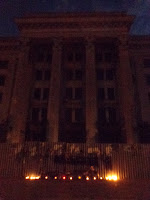On our next half-Friday, we decided to try a camping trip in Podilski Tovtry National Park. Due to some road construction and accidents, it was past dark by the time we started descending down the sketchy backroads to get to Bakota Bay. Fortunately, at the end of the road was a camp where we could set up our tent right next to the river (left). Unfortunately, our fellow campers used this as an opportunity to start fishing very early in the morning, which did not amuse Sage (right).
After a peaceful riverside breakfast and swim, we decided to break camp because while on the rough roads to the region, we broke our muffler. On the way into town in search of a mechanic, we stopped at the top of the canyon, so we could a full view of the Dniester River (top left). Many communities erect Orthodox crosses -- whose top bar represents the "King of Jews" sign and whose bottom bar represents the foot rest of the crucifix (top right) -- so it was little surprise that there would be one near the site of a Cave Monastery, which was abandoned after it flooded multiple times (bottom).In Kamianets-Podilskyi, we found a garage that fixed our muffler for $16, and the Monte-Kristo Hotel gave us a room last-minute for $16. After a three-hour distraction, we set out to explore the Old Town, which meant crossing a bridge above a different river canyon (left). The downtown cluster sits on a promontory that can be crossed by foot in less than a half-hour, even at a leisurely pace. On the opposite side of the spit, there is another bridge across the canyon, where you can look out toward St. George's Cathedral across the river (right).
Although it clearly was once big enough to carve a huge canyon (top), the Smotrych River now has a calm flow that invites residents of the canyon communities to cool off during the summer (bottom left). TJ and I cooled off in the shade at a bar built into the side of an electricity plant powered by the waterway (bottom right).
As the sun began to set, we headed back to the top of the city so we could explore the Old Town sites, which represent a merging of the cultures that have influenced the town. The former Polish Magistrate and current Town Hall sits on the edge of the Polish square (left). St. Stepanos' Belltower is just a few blocks from the Armenian square (right), where we enjoyed a snack of mlyntsi at Kava vid Politsmeystera.
But by far, the most eye-catching building in the city is the Old Fortress, currently nominated to become a UNESCO World Heritage Site (left). The view upon approach over the Turkish Bridge (yet another culture that contributed to the city) definitely puts it in the running to receive full status, in my opinion (right).
The next morning, we returned to the fortress, so we could see its amazing preservation from the inside. The castle is enchanting for kids and adults alike because you are allowed to crawl through all the walls (top left). Its towers provide some great views of the surrounding landscape, including the nearby Memorial to Seven Peoples (top right), as well as of the interior of the castle itself (middle). Throughout the fortress, there are attempts to recreate its 11th-century technology, such as an entirely wooden "cannon" in the battery (bottom left). Even the snack bar was getting into the spirit, serving up food cooked via medieval methods (bottom right).









































